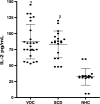Pattern of serum cytokine expression and T-cell subsets in sickle cell disease patients in vaso-occlusive crisis
- PMID: 20130127
- PMCID: PMC2849336
- DOI: 10.1128/CVI.00145-09
Pattern of serum cytokine expression and T-cell subsets in sickle cell disease patients in vaso-occlusive crisis
Abstract
The pathogenesis of sickle vaso-occlusive crisis (VOC) in sickle cell disease (SCD) patients involves the accumulation of rigid sickle cells and the stimulation of an ongoing inflammatory response, as well as the stress of infections. The immune response, via cytokine imbalances and deregulated T-cell subsets, also has been proposed to contribute to the development of VOC. In this study, a panel of high-sensitivity cytokine kits was used to investigate cytokines in the sera of SCD patients in VOC. The results were compared primarily with those for stable SCD patients and secondarily with those for normal healthy people who served as controls. The cytokines studied included interleukin-2 (IL-2), IL-4, and IL-10. Lymphocyte subsets of patients with VOC were also studied and were compared with those of both control groups (20 stable patients without crisis [SCD group] and 20 normal healthy controls [NHC]). The VOC group was notable for remarkably elevated levels of IL-4, among the three cytokines tested, compared with those for the SCD and NHC groups. Patients with VOC also differed from stable SCD patients and NHC by having notably lower IL-10 levels, as well as the lowest ratio of CD4(+) to CD8(+) T cells (0.7). The patterns of the proinflammatory cytokine IL-2 did not differ between VOC and stable SCD patients, but NHC had significantly lower IL-2 levels than both the VOC and SCD groups. Our results demonstrate coexisting levels, both high and low, of TH1- and TH2-type cytokines, as well as diminished levels of T-cell subsets in VOC. These results are discussed in an effort to better understand the importance of the immune system profile in the pathogenesis of sickle cell VOC. Since the possibility that a cytokine imbalance is implicated in the pathogenesis of sickle cell crisis has been raised, our results should prompt further investigation of the host immune response in terms of TH1 and TH2 balance in sickle cell crisis.
Figures


Similar articles
-
Serum IL-6, IL-10, and TNFα levels in pediatric sickle cell disease patients during vasoocclusive crisis and steady state condition.Cytokine. 2015 Mar;72(1):43-7. doi: 10.1016/j.cyto.2014.11.030. Epub 2015 Jan 5. Cytokine. 2015. PMID: 25569375
-
Cytokine profile of sickle cell disease in Oman.Am J Hematol. 2004 Dec;77(4):323-8. doi: 10.1002/ajh.20196. Am J Hematol. 2004. PMID: 15551290
-
Markers of endothelial dysfunction and leucocyte activation in Saudi and non-Saudi haplotypes of sickle cell disease.Ann Hematol. 2017 Jan;96(1):141-146. doi: 10.1007/s00277-016-2823-7. Epub 2016 Sep 30. Ann Hematol. 2017. PMID: 27686084
-
Systematic Review of Crizanlizumab: A New Parenteral Option to Reduce Vaso-occlusive Pain Crises in Patients with Sickle Cell Disease.Pharmacotherapy. 2020 Jun;40(6):535-543. doi: 10.1002/phar.2409. Epub 2020 May 20. Pharmacotherapy. 2020. PMID: 32350885
-
Systematic Review of l-glutamine for Prevention of Vaso-occlusive Pain Crisis in Patients with Sickle Cell Disease.Pharmacotherapy. 2019 Nov;39(11):1095-1104. doi: 10.1002/phar.2329. Epub 2019 Oct 9. Pharmacotherapy. 2019. PMID: 31505045
Cited by
-
Blood viscosity and the expression of inflammatory and adhesion markers in homozygous sickle cell disease subjects with chronic leg ulcers.PLoS One. 2013 Jul 26;8(7):e68929. doi: 10.1371/journal.pone.0068929. Print 2013. PLoS One. 2013. PMID: 23922670 Free PMC article.
-
Are IL-1 family cytokines important in management of sickle cell disease in Sub-Saharan Africa patients?Front Immunol. 2023 Mar 9;14:954054. doi: 10.3389/fimmu.2023.954054. eCollection 2023. Front Immunol. 2023. PMID: 36969226 Free PMC article.
-
Systemic T Cell Subsets and Cytokines in Patients With Homozygous Sickle Cell Disease and Asymptomatic Urinary Tract Infections in Togo.Ochsner J. 2021 Summer;21(2):163-172. doi: 10.31486/toj.20.0061. Ochsner J. 2021. PMID: 34239376 Free PMC article.
-
Alteration of lymphocyte phenotype and function in sickle cell anemia: Implications for vaccine responses.Am J Hematol. 2016 Sep;91(9):938-46. doi: 10.1002/ajh.24438. Epub 2016 Jul 14. Am J Hematol. 2016. PMID: 27237467 Free PMC article. Review.
-
Preconditioning with hemin decreases Plasmodium chabaudi adami parasitemia and inhibits erythropoiesis in BALB/c mice.PLoS One. 2013;8(1):e54744. doi: 10.1371/journal.pone.0054744. Epub 2013 Jan 24. PLoS One. 2013. PMID: 23358441 Free PMC article.
References
-
- Ballas, S. K., J. Larner, E. D. Smith, et al. 1988. Rheologic predictors of the severity of the painful sickle cell crisis. Blood 72:1216-1223. - PubMed
-
- Ballas, S. K. 1995. The sickle cell painful crisis in adults: phases and objective signs. Hemoglobin 19:323-333. - PubMed
-
- Ballas, S. K., and N. Mohandas. 1996. Pathophysiology of vaso-occlusion. Hematol. Oncol. Clin. North Am. 10:1221-1239. - PubMed
-
- Beddall, A. 1990. Anaemias. Practitioner 234:713-726. - PubMed
MeSH terms
Substances
LinkOut - more resources
Full Text Sources
Other Literature Sources
Medical
Research Materials

